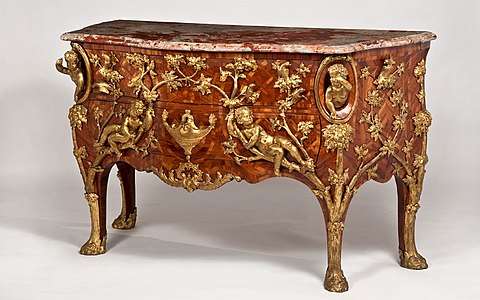Charles Cressent
Charles Cressent (1685–1768) was a French furniture-maker, sculptor and fondeur-ciseleur of the régence style. As the second son of François Cressent, sculpteur du roi, and grandson of Charles Cressent, a furniture-maker of Amiens, who also became a sculptor, he inherited the tastes and aptitudes which were likely to make a finished designer and craftsman. Even more important perhaps was the fact that he was a pupil of André Charles Boulle. Trained in such surroundings, it is not surprising that he should have reached a degree of achievement which has to a great extent justified the claim that he was the best decorative artist of the 18th century. Cressent's distinction is closely connected with the regency, but his earlier work had affinities with the school of Boulle, while his later pieces were full of originality.
As Geoffrey Bellaigue suggests, "Cressent was in his opinion and in that of his contemporaries more than just a skilled cabinet maker and sculptor...he was a collector of refined taste and a talented designer"[1].
Cressent was likewise a sculptor, and among his plastic work is known to have been a bronze bust of Louis d'Orléans, Duke of Chartres, the son of Philippe d'Orléans, Duke of Orléans (later Regent of France for Louis XV), for whom Cressent had made one of the finest examples of French furniture of the 18th century the famous medaillier now in the Bibliothèque Nationale. Cressent's bronze mounts were executed with a sharpness of finish and a grace and vigour of outline which were hardly excelled by his great contemporary Jacques Caffieri. His female figures placed at the corners of tables are indeed among the most delicious achievements of the great days of the French metal worker.
The work of identification is rendered comparatively easy in his case by the fact that he published catalogues of three sales of his work. These catalogues are highly characteristic of the man, who shared in no small degree the personal bravura of Cellini, and could sometimes execute almost as well. He did not hesitate to describe himself as the author of a clock worthy to be placed in the very finest cabinets, the most distinguished bronzes, or pieces of the most elegant form adorned with bronzes of extra richness. He worked much in marqueterie, both in tortoiseshell and in brilliant colored woods. He was indeed an artist to whom colour appealed with especial force. The very type and exemplar of the feeling of the regency.
Examples of work

Writing-table, c. 1725, Wallace Collection, UK
Commode, c. 1730, Waddesdon Manor, UK
Commode, ca. 1745-49, Metropolitan Museum of Art, USA
Filing-Cabinet and clock, c. 1740-1745, Wallace Collection, UK
Cartel clock, c. 1747, Wallace Collection, UK
 Chest of drawers by Charles Cressent, Paris, c. 1730, with Sevres porcelain - Waddesdon Manor - Buckinghamshire, England
Chest of drawers by Charles Cressent, Paris, c. 1730, with Sevres porcelain - Waddesdon Manor - Buckinghamshire, England Charles Cressent, coppia di medaglieri, parigi 1750
Charles Cressent, coppia di medaglieri, parigi 1750 Charles Cressent, coppia di mobili con scaffali da biblioteca, parigi, 1735
Charles Cressent, coppia di mobili con scaffali da biblioteca, parigi, 1735 Charles Cressent, tavolo da segreteria, parigi 1750
Charles Cressent, tavolo da segreteria, parigi 1750%2C_parigi_1757-65_ca.%2C_con_un_vaso_celadon_parigino_del_1720-30_ca.jpg) Charles Cressent, cantoniera (da una coppia), parigi 1757-65 ca., con un vaso celadon parigino del 1720-30
Charles Cressent, cantoniera (da una coppia), parigi 1757-65 ca., con un vaso celadon parigino del 1720-30
References
- De Bellaigue, Geoffrey (1974). Furniture, clocks and gilt bronzes in two volumes : published for the National Trust (for places of historic interest or natural beauty, London). Office du livre. ISBN 0707800102. OCLC 728116780.

- Geoffrey Bellaigue. (1974), Furniture, Clocks and Gilt Bronzes. (Office du Livre for the National Trust: Fribourg)
External links
| Wikimedia Commons has media related to Charles Cressent. |
- Charles Cressent in American public collections, on the French Sculpture Census website

- Charles Cressent's chest of drawers at Waddesdon Manor